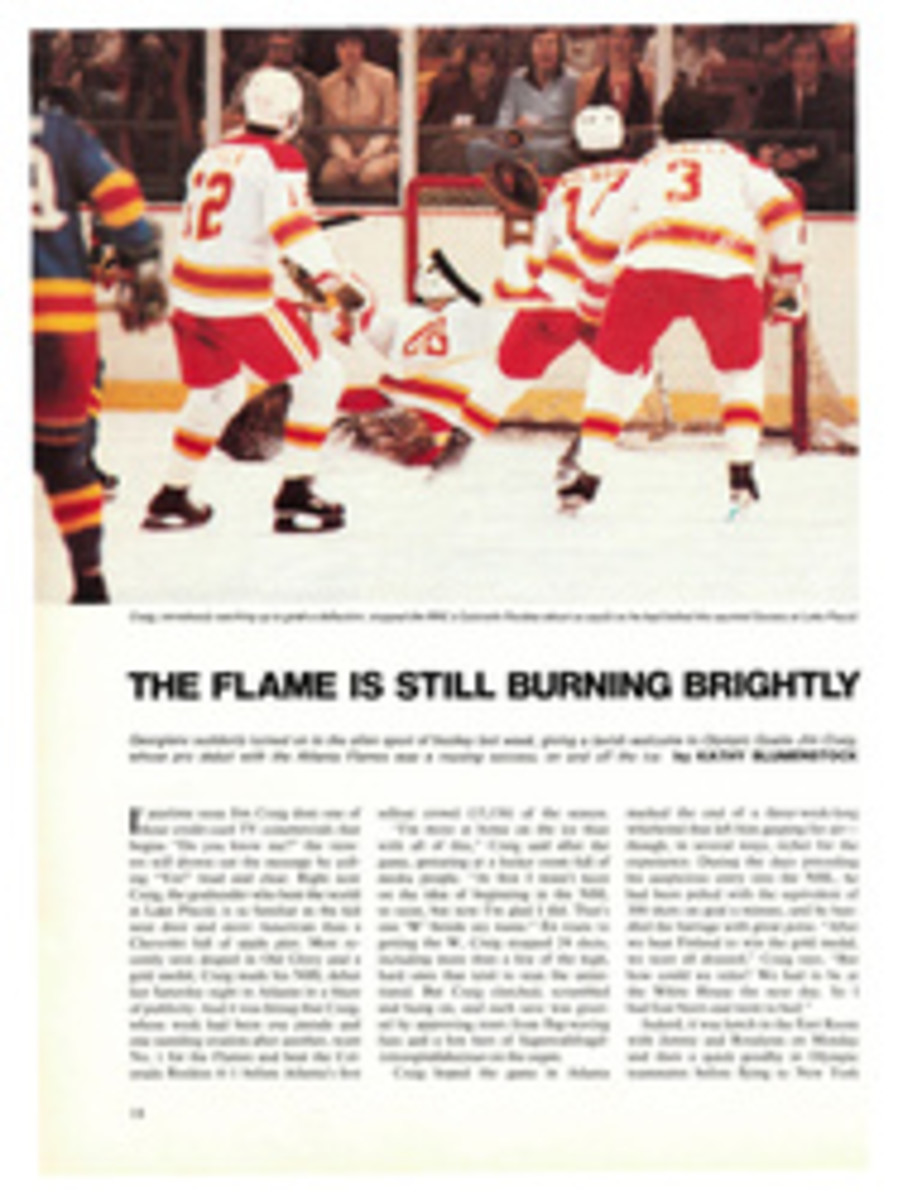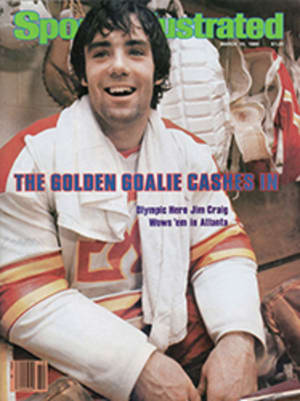
High, wide and handsome
Last Friday nightin Madison Square Garden the officials for the USA Indoor Track and FieldChampionships had presented Earl Bell with a dilemma. Bell had just won thepole vault by sailing over a bar he thought was positioned at 18'1", thesame height as Dan Ripley's 1979 meet record. That had been the only time allnight that Bell had cleared the bar. He hadn't bothered with any practicejumps, had missed twice at his opening height of 17'8½" and had decided toforgo his third attempt at that height to take a single whack at 18'1". Butin remeasuring to certify Bell's tying of the meet record, the officialsdiscovered that the bar was not at 18'1" but at 18'2¼"—the highestfirst clearance ever and, of course, a meet record. "Well, what d'yaknow," said Bell.
Thus arose Bell'sdilemma. The very officials who had measured the bar at two different heightsjust moments before were now asking him how high he wanted the bar set for hisnext attempt. Bell decided to try to break the indoor world of 18'6" set byKonstantin Volkov of the U.S.S.R. last month. In the pole vault, world recordsusually progress in fractions of an inch, so Bell wanted the bar set at18'6½". But dare he request such a precise measurement from officials whohad managed to be 1¼" off on his last vault?
Perhaps he shouldsimply have the bar moved to 18'5" in the hope that it would remeasure outat better than 18'6". But then again the officials might go the other way,and he could end up with a surprise in reverse. After all, just the previousweekend in San Francisco, Bell had been given an ovation when he apparently hadbecome the first man to vault 18 feet in the Cow Palace. But a remeasurement ofthe height came out at 17'10½". To play it safe, therefore, perhaps Bellshould now ask that the bar be raised to 19 feet; that way he would have such awide margin for error that the bar certainly would still be above 18'6"even after the officials had at it.
This dilemmaproving hopelessly unsolvable, Bell simply asked for 18'6½", crossed hisfingers and readied himself for three tries at a world record.
Bell's vaultingbrought a brief spark of life to a lackluster meet that had been billed as"America's Epic Athletics Event." That's not athletic, mind you, butathletics, as in the Athletics Congress, the newly formed body that has takenover the management of track and field in America from the AAU, as well as therunning of these annual indoor competitions, which used to be known as the AAUindoor championships. But as has so frequently been the case in the past, themost epic thing about this year's meet was the list of no-shows. This timearound, the roll of the missing included hurdlers Renaldo Nehemiah and GregFoster, milers Steve Scott and Don Paige, high-jumper Joni Huntley andmiddle-distance runners Mary Decker, Francie Larrieu and Jan Merrill.
While the fieldmay have been missing many stars, there were some noteworthy performances. RodMilburn, 29, capped his comeback season from pro exile by winning the 60-yardhurdles; Texas A&M football star Curtis Dickey took the 60-yard dash in ablazing 6.09; Eamonn Coghlan won the three-mile in 13:02.8, nearly five secondsfaster than Tracy Smith's 1973 meet and U.S. record; and a Philadelphia PioneerClub sprint medley relay team turned a blistering world-record 2:01,highlighted by Herman Frazier's unofficial 20.9 220-yard third leg. Before thecompetition began, a representative of the Athletics Congress had, at therequest of the athletes, phoned the White House to invite President Carter toattend the meet and discuss the Olympic boycott. The President was anotherno-show, so in lieu of a direct encounter, the competitors drew up a petition,just as they had at the earlier meets this season. Only instead of supportingthe boycott, their petition opposed it. And many American athletes signedit.
Perhaps EvelynAshford best summed up the athletes' growing frustration while also explainingtheir generally flat performances since the boycott was proposed on Jan. 20."All the talk of the boycott has really taken a lot out of me," shesaid after winning the women's 60-yard dash in 6.76 seconds. "I've beenpretty depressed. It's been difficult. Realistically, I know we probably won'tgo to Moscow. I'm still hoping—I have to hold on to that hope. But it hasaffected me. I don't have a goal anymore. I don't know what to do now. I'vetried to set new goals, but the Olympic Games were going to beeverything."
Anothercompetitor who had been focusing all his energy toward Moscow was long-jumperLarry Myricks—and with good reason. Myricks made the U.S. Olympic team in 1976but broke an ankle in Montreal while warming up. He has been waiting for asecond chance ever since, and after winning last year's World Cup at27'11½", the second-longest jump in history to Bob Beamon's 29'2½", itappeared that he would go to Moscow as the favorite for the gold medal. But asif the boycott weren't frustrating enough, Myricks discovered last week that hecouldn't even get a moment in the spotlight at his own national indoorchampionship.
Myricks was oneof the star attractions at the Garden. One could easily argue that he has beenthe top American male on the indoor circuit this year. In January at a meet inJohnson City, Tenn., he broke Beamon's 12-year-old indoor world mark of27'2¾" by three inches. Two weeks ago in San Diego he increased the recordto 27'6". But last Friday, the long jump was scheduled at 3 p.m., whenalmost no one but other athletes could be in attendance.
Among themultitude that didn't get to see Myricks jump were his parents, who had flownin from Jackson, Miss. After calling the Garden and being assured that nofinals would take place before 7 p.m., they spent part of the day withrelatives in New Jersey. Still, they headed for the meet early. Fightingtraffic and ticket lines, they finally entered the arena about 5 p.m., momentsafter their son had won his second straight indoor title with a 26'11½"leap.
"Are yougonna jump again?" asked Myricks' 6-year-old cousin, who had come alongfrom New Jersey. When Myricks shook his head, she asked plaintively, "Whynot?" She should have asked the Athletics Congress.
"I've gottenused to this," said Myricks, a soft-spoken 23-year-old who works as arecreation specialist in Florida. "I've been jumping well for four yearsnow, and I've never gotten the recognition I think I've deserved."
In contrast,almost four years have gone by since Bell last vaulted really well. In 1976, atthe age of 20, he held the outdoor world record of 18'7¼". Even then he wasa veteran. He had vaulted almost all his life back home in Jonesboro, Ark.,where his 57-year-old father, William, a pathologist, still vaults as a hobby.When Earl and his three brothers were youngsters, their father would handmakepoles for them because none were commercially available that were flexibleenough to be handled by 80-to 90-pound vaulters. Dr. Bell would start byrolling craft paper to the desired diameter and then he would wrap the papertube with fiber glass cloth purchased at Sears, eyeballing it to what looked tobe the right thickness and binding it all together with a coating of resin.Through trial and error, he learned how to use these materials to produceprecise degrees of flexibility and strength. When he was 14 and weighed nearly100 pounds, Earl set a state junior high school record of 12'7½" with hisfirst store-bought pole.
Bell lost hisworld record at the '76 Olympic Trials when Dave Roberts cleared 18'8¼",still the world's standard. He then finished sixth in Montreal and followedthat with two poor seasons, during which he suffered pain in his back and leftside. By the end of 1978 his left leg hurt so much that he could hardly jog. Inearly 1979 Pasadena chiropractor Dr. Leroy Perry discovered the cause when hemeasured Bell and found that his left leg was ‚Äö√Ñ√∂‚àö√±‚àöœÄ of an inch shorter than hisright. To compensate, Bell gradually built up the heel of his left shoe, sothat now when he is vaulting he appears to be wearing one track flat and oneslightly out-of-style wedgie. At the moment this ‚Äö√Ñ√∂‚àö√±‚àöœÄ-inch buildup has placed Bellin violation of an international track rule that specifies a limit of about lAinch (13 mm). The rule was written to prevent athletes from gaining height andspring by building up both shoes. Bell has appealed his case. "I'm nottrying to cheat," he pleads. "I just want two legs that are the samelength. And there's no way I can cut the other one down."
This year Bellmoved from Arkansas to Live Oak, Calif., on the Feather River north ofSacramento, where he is training under Dick Tomlinson, a sometime pole-vaultcoach who manages a kiwi farming corporation. A kiwi is a tart, egg-shapedfruit brought to America from New Zealand and so little known in the U.S. thatBell occasionally lists his affiliation as the Whatsakiwi Track Club. Tomlinsonhas improved Bell's technique, with gratifying results. In 1980 Bell has beenthe most consistent U.S. vaulter—and the loftiest, with an 18'3½" jump lastmonth in Winnipeg. Not that training has come easy. A recent flood picked upBell's homemade wooden runway and carried it off", "possibly to thePacific," he says. The foam rubber landing pad also floated away, butTomlinson hopped in a rowboat, chased the 14' x 16' pad down and tied it to atree.
Such trials andtribulations no doubt deserve an indoor world record, but Bell will have towait a little while longer to get his. He failed on all three attempts at theGarden, which is just as well because if he had cleared the bar it probablywould have been remeasured at 18'5¾". No matter. With his single successfuljump, Bell set a meet record, won his first national indoor championship, gotthe evening's biggest roar from the Garden crowd and proved that he can measureup to the best in the world.
PHOTO
Myricks' 26'11½" leap was all but unwatched.
PHOTO
Bell cleared a meet-record 18'1"—oops, 18'2¼".

